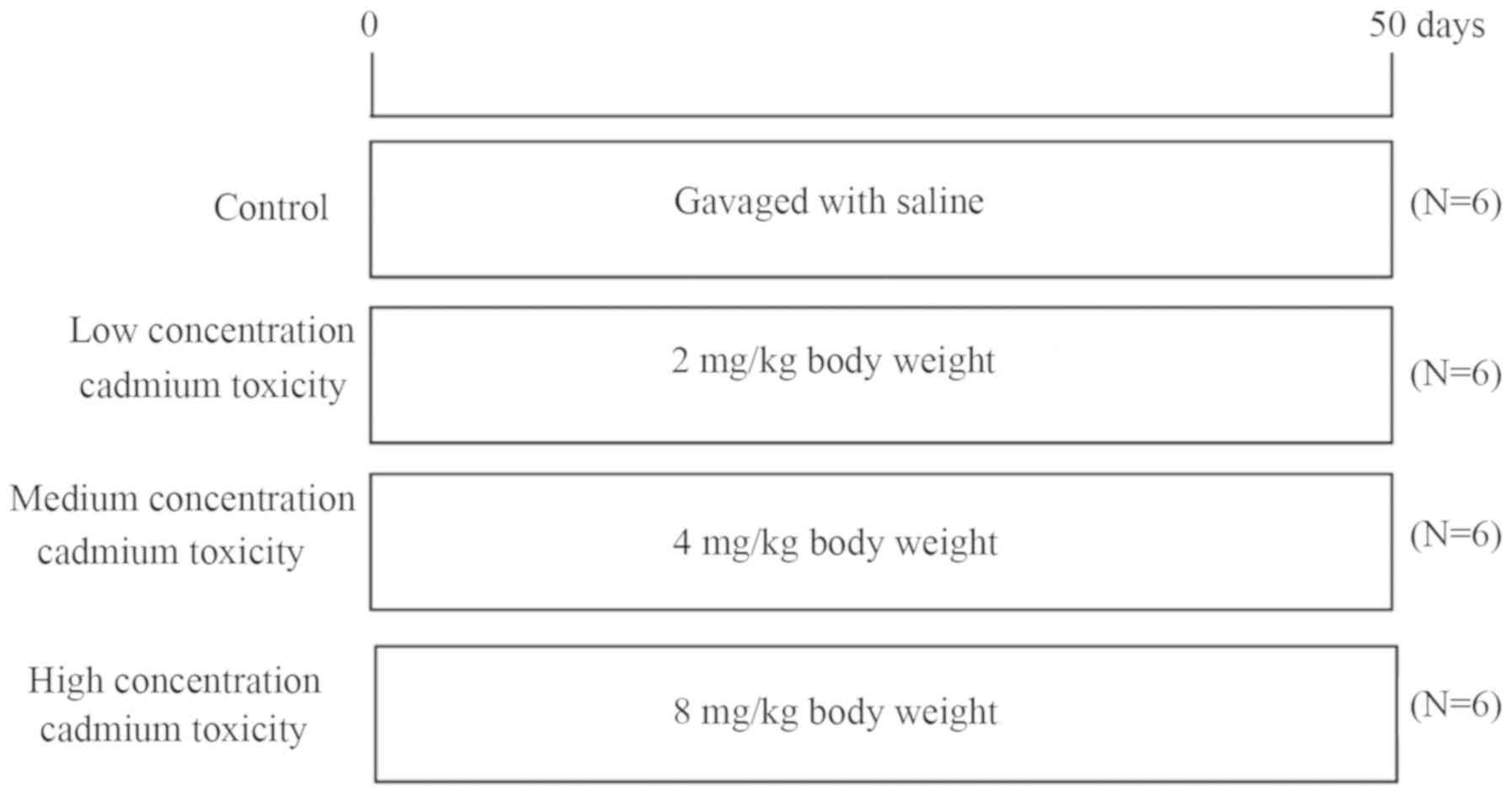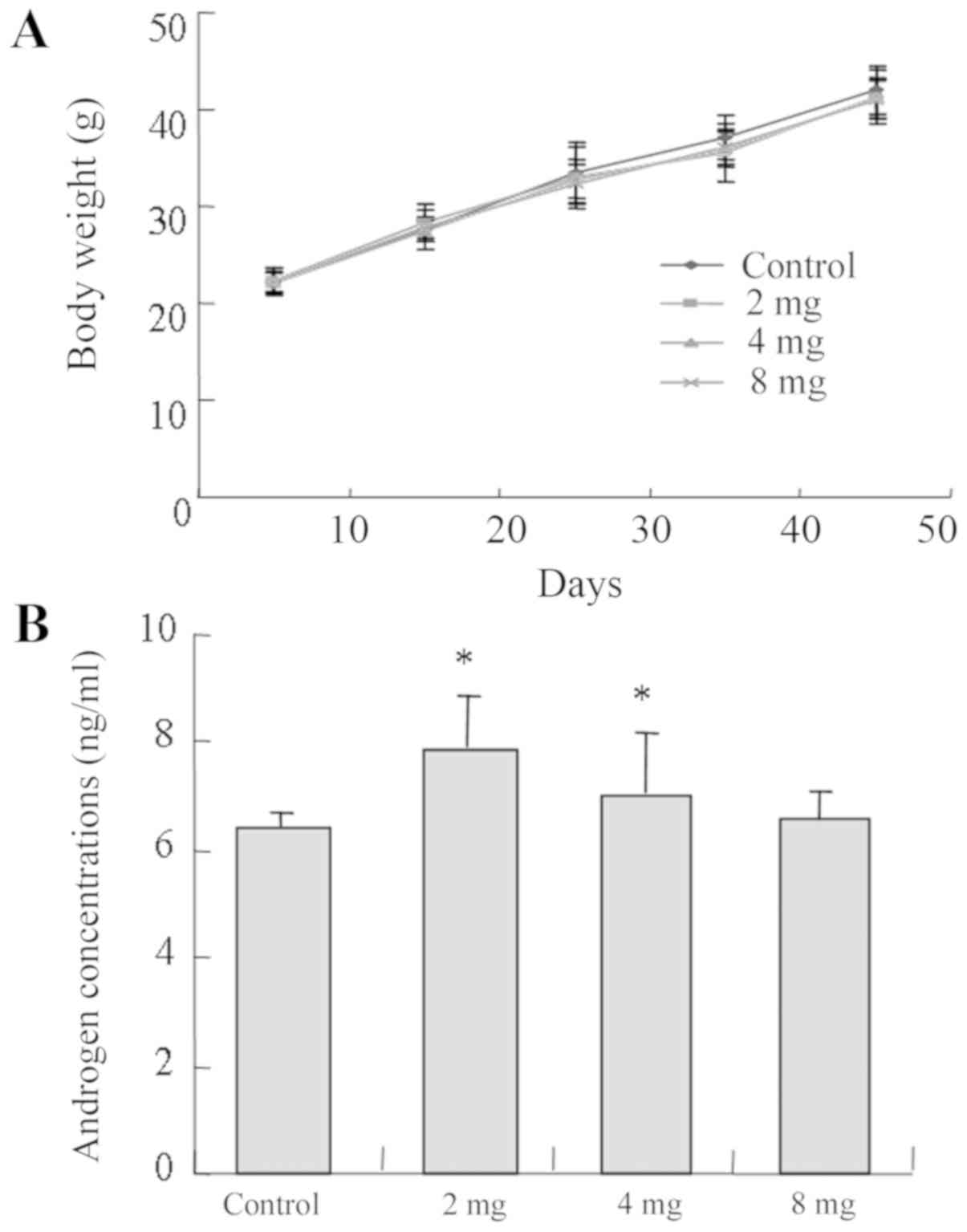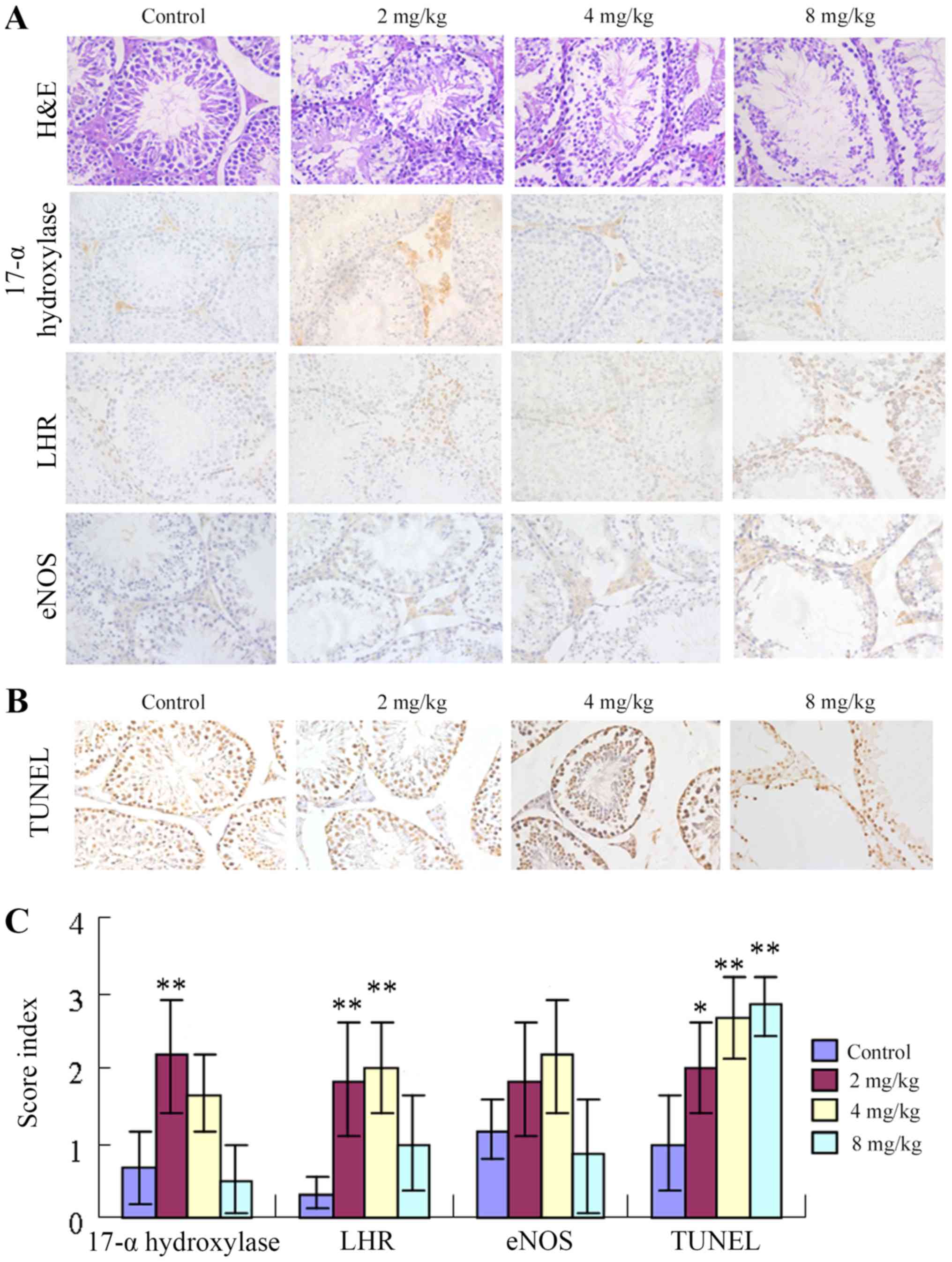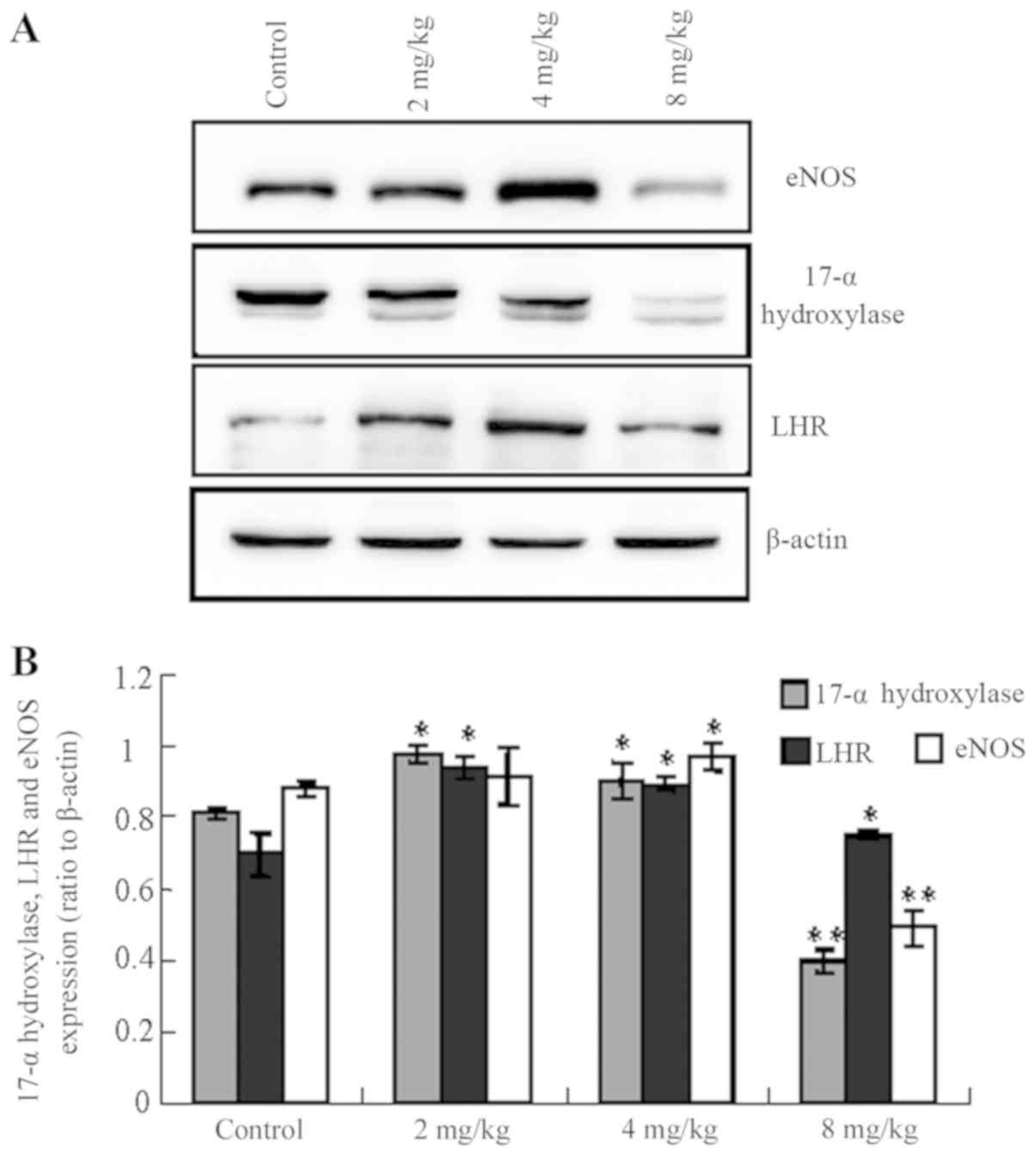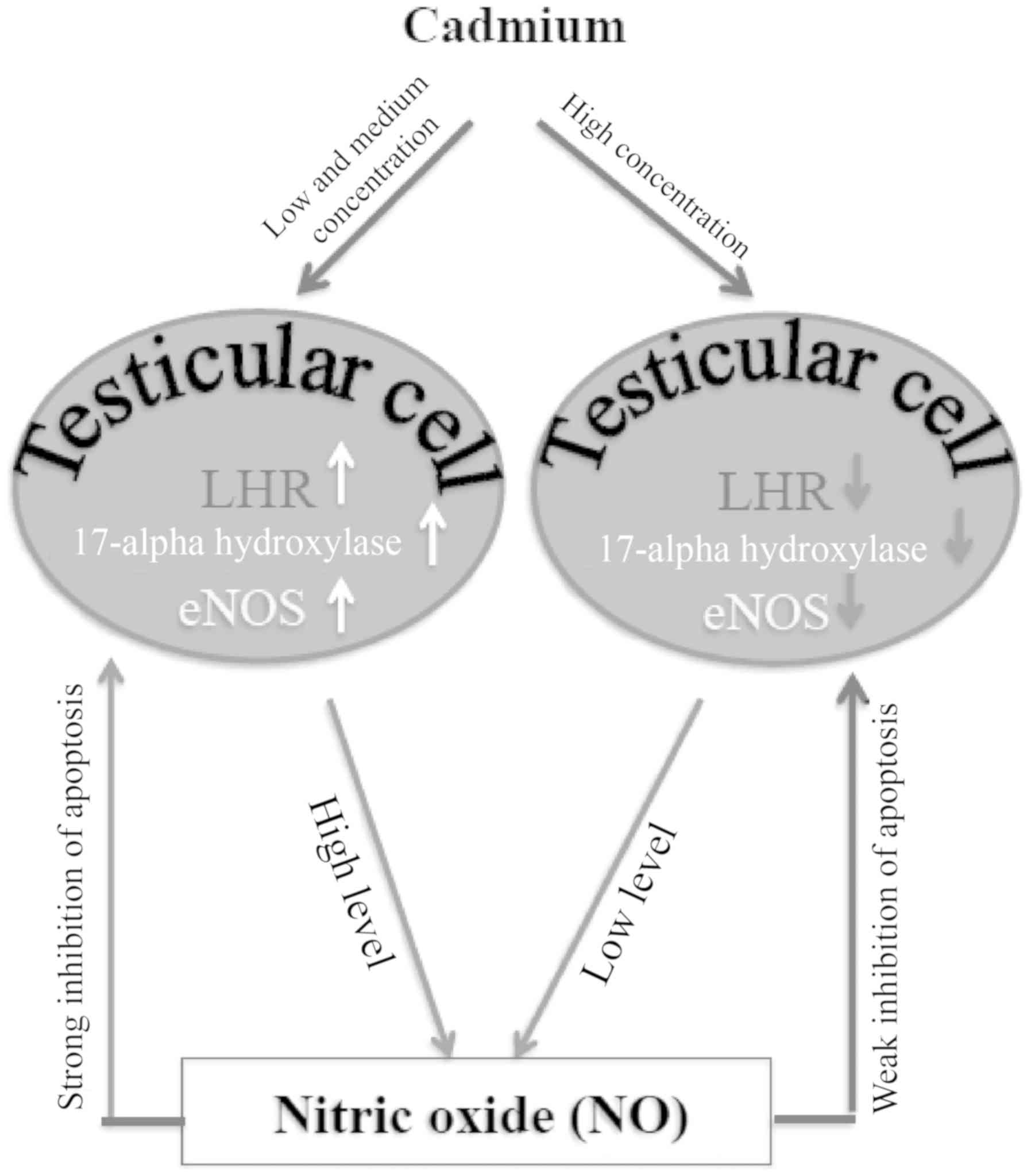|
1
|
Vandenberg LN, Colborn T, Hayes TB,
Heindel JJ, Jacobs DR Jr, Lee DH, Shioda T, Soto AM, vom Saal FS,
Welshons WV, et al: Hormones and endocrine-disrupting chemicals:
Low-dose effects and nonmonotonic dose responses. Endocr Rev.
33:378–455. 2012. View Article : Google Scholar : PubMed/NCBI
|
|
2
|
Medina MF, Arrieta MC, Villafañe MN,
Klyver SMR, Odstrcil IMA and González ME: Early signs of toxicity
in testes and sperm of rats exposed to low cadmium doses. Toxicol
Ind Health. 33:576–587. 2017. View Article : Google Scholar : PubMed/NCBI
|
|
3
|
Akinloye O, Arowojolu AO, Shittu OB and
Anetor JI: Cadmium toxicity: A possible cause of male infertility
in Nigeria. Reprod Biol. 6:17–30. 2006.PubMed/NCBI
|
|
4
|
Luevano J and Damodaran C: A review of
molecular events of cadmium-induced carcinogenesis. J Environ
Pathol Toxicol Oncol. 33:183–194. 2014. View Article : Google Scholar : PubMed/NCBI
|
|
5
|
Niknafs B, Salehnia M and Kamkar M:
Induction and determination of apoptotic and necrotic cell death by
cadmium chloride in testis tissue of mouse. J Reprod Infertil.
16:24–29. 2015.PubMed/NCBI
|
|
6
|
De Angelis C, Galdiero M, Pivonello C,
Salzano C, Gianfrilli D, Piscitelli P, Lenzi A, Colao A and
Pivonello R: The environment and male reproduction: The effect of
cadmium exposure on reproductive function and its implication in
fertility. Reprod Toxicol. 73:105–127. 2017. View Article : Google Scholar : PubMed/NCBI
|
|
7
|
Marettoá E, Maretta M and Leqáth J: Toxic
effects of cadmium on testis of birds and mammals: A review. Anim
Reprod Sci. 155:1–10. 2015. View Article : Google Scholar : PubMed/NCBI
|
|
8
|
Verqilio CS, Moreira RV, Carvalho CE and
Melo EJ: Evolution of cadmium effects in the testis and sperm of
the tropical fish Gymnotus carapo. Tissue Cell. 47:132–139. 2015.
View Article : Google Scholar : PubMed/NCBI
|
|
9
|
Yang Q, Li P, Wen Y, Li S, Chen J, Liu X,
Wang L and Li X: Cadmium inhibits lysine acetylation and
succinylation inducing testicular injury of mouse during
development. Toxicol Lett. 291:112–120. 2018. View Article : Google Scholar : PubMed/NCBI
|
|
10
|
Ali I, Damdimopoulou P, Stenius U,
Adamsson A, Mäkelä SI, Åkesson A, Berglund M, Håkansson H and
Halldin K: Cadmium-induced effects on cellular signaling pathways
in the liver of transgenic estrogen reporter mice. Toxicol Sci.
127:66–75. 2012. View Article : Google Scholar : PubMed/NCBI
|
|
11
|
Schneider SN, Liu Z, Wang B, Miller ML,
Afton SE, Soleimani M and Nebert DW: Oral cadmium in mice carrying
5 versus 2 copies of the Slc39a8 gene: Comparison of uptake,
distribution, metal content, and toxicity. Int J Toxicol. 33:14–20.
2014. View Article : Google Scholar : PubMed/NCBI
|
|
12
|
Hu H, Lu X, Cen X, Chen X, Li F and Zhong
S: RNA-Seq identifies key reproductive gene expression alterations
in response to cadmium exposure. Biomed Res Int. 2014:5292712014.
View Article : Google Scholar : PubMed/NCBI
|
|
13
|
Angenard G, Muczynski V, Coffigny H,
Pairault C, Duquenne C, Frydman R, Habert R, Rouiller-Fabre V and
Livera G: Cadmium increases human fetal germ cell apoptosis.
Environ Health Perspect. 118:331–337. 2010. View Article : Google Scholar : PubMed/NCBI
|
|
14
|
Singh KP, Kumari R, Pevey C, Jackson D and
DuMond JW: Long duration exposure to cadmium leads to increased
cell survival, decreased DNA repair capacity, and genomic
instability in mouse testicular Leydig cells. Cancer Lett.
279:84–92. 2009. View Article : Google Scholar : PubMed/NCBI
|
|
15
|
Ji YL, Wang H, Zhao XF, Wang Q, Zhang C,
Zhang Y, Zhao M, Chen YH, Meng XH and Xu DX: Crosstalk between
endoplasmic reticulum stress and mitochondrial pathway mediates
cadmium-induced germ cell apoptosis in testes. Toxicol Sci.
124:446–459. 2011. View Article : Google Scholar : PubMed/NCBI
|
|
16
|
Oliveira H, Lopes T, Almeida T, Pereira
Mde L and Santos C: Cadmium-induced genetic instability in mice
testis. Hum Exp Toxicol. 31:1228–1236. 2012. View Article : Google Scholar : PubMed/NCBI
|
|
17
|
Veeriah V, Saran U, Swaminathan A,
Balaguru UM, Thangaraj P, Nagarajan S, Rajendran VK and Chatterjee
S: Cadmium-induced embryopathy: Nitric oxide rescues teratogenic
effects of Cadmium. Toxicol Sci. 144:90–104. 2015. View Article : Google Scholar : PubMed/NCBI
|
|
18
|
Seid Alian N, Khodarahmi P and Naseh V:
The effect of cadmium on apoptotic genes mRNA expression of Bax and
Bcl-2 in small intestine of rats. Iran J Pathol. 13:408–414.
2018.PubMed/NCBI
|
|
19
|
Breton J, Le Clère K, Daniel C, Sauty M,
Nakab L, Chassat T, Dewulf J, Penet S, Carnoy C, Thomas P, et al:
Chronic ingestion of cadmium and lead alters the bioavailability of
essential and heavy metals, gene expression pathways and
genotoxicity in mouse intestine. Arch Toxicol. 87:1787–1795. 2013.
View Article : Google Scholar : PubMed/NCBI
|
|
20
|
Uno Y, Hosaka S and Yamazaki H:
Identification and analysis of CYP7A1, CYP17A1, CYP20A1, CYP27A1
and CYP51A1 in cynomolgus macaques. J Vet Med Sci. 76:1647–1650.
2014. View Article : Google Scholar : PubMed/NCBI
|
|
21
|
Chen H, Ge RS and Zirkin BR: Leydig cells:
From stem cells to aging. Mol Cell Endocrinol. 306:9–16. 2009.
View Article : Google Scholar : PubMed/NCBI
|
|
22
|
Ge R, Chen G and Hardy MP: The role of the
Leydig cell in spermatogenic function. Adv Exp Med Biol.
636:255–269. 2008. View Article : Google Scholar : PubMed/NCBI
|
|
23
|
Smith LB and Walker WH: The regulation of
spermatogenesis by androgens. Semin Cell Dev Biol. 30:2–13. 2014.
View Article : Google Scholar : PubMed/NCBI
|
|
24
|
Rey RA, Musse M, Venara M and Chemes HE:
Ontogeny of the androgen receptor expression in the fetal and
postnatal testis: Its relevance on Sertoli cell maturation and the
onset of adult spermatogenesis. Microsc Res Tech. 72:787–95. 2009.
View Article : Google Scholar : PubMed/NCBI
|
|
25
|
Chang C, Chen YT, Yeh SD, Xu Q, Wang RS,
Guillou F, Lardy H and Yeh S: Infertility with defective
spermatogenesis and hypotestosteronemia in male mice lacking the
androgen receptor in Sertoli cells. Proc Natl Acad Sci USA.
101:6876–6881. 2004. View Article : Google Scholar : PubMed/NCBI
|
|
26
|
Zhang F and Liao L: Role and significance
of nitric oxide neurochemical remodeling in lower urinary tract
dysfunction after spinal cord injury. Chin J Urol. 332012.
|
|
27
|
Ren YP, Sun L, Shao XY, Chen J, Xiong B
and Nong LL: Expressions of eNOS and cytochrome P450 in the testis
of sexually mature SD rats and their significance. Zhonghua Nan Ke
Xue. 15:911–914. 2009.(In Chinese). PubMed/NCBI
|
|
28
|
Lim KH, Ancrile BB, Kashatus DF and
Counter CM: Tumour maintenance is mediated by eNOS. Nature.
452:646–649. 2008. View Article : Google Scholar : PubMed/NCBI
|
|
29
|
Alpcan S, Başar H, Aydos TR, Kul O, Kısa Ü
and Başar MM: Apoptosis in testicular tissue of rats after
vasectomy: Evaluation of eNOS, iNOS immunoreactivities and the
effects of ozone therapy. Turk J Urol. 40:199–206. 2014. View Article : Google Scholar : PubMed/NCBI
|
|
30
|
Kondo Y, Ishikawa T, Yamaguchi K, Yada T
and Fujisawa M: Oral administration of tetrahydrobiopterin
attenuates testicular damage by reducing nitric oxide synthase
activity in a cryptorchid mouse model. J Androl. 29:153–163. 2008.
View Article : Google Scholar : PubMed/NCBI
|
|
31
|
Guo J, Jia Y, Tao SX, Li YC, Zhang XS, Hu
ZY, Chiang N, Lue YH, Hikim AP, Swerdloff RS, et al: Expression of
nitric oxide synthase during germ cell apoptosis in testis of
cynomolgus monkey after testosterone and heat treatment. J Androl.
30:190–199. 2009. View Article : Google Scholar : PubMed/NCBI
|
|
32
|
Zheng LP, Zhu X, Yang L, et al: Analysis
and correlation study of trace elements in blood and semen of male
sterile patients. Mod Prev Med. 1464–1466. 2012.
|
|
33
|
Cheng DZ, Du AL, Li CS, et al: Scavenging
of superoxide free radicals generated by autooxidation of
pyrogallol with ginger extract. Chin Spices. 35–39. 2014.
|
|
34
|
Saito H, Good S, Sato S, Ito A, Ikumi Y,
Tanaka S, Ida T, Fujii S, Akaike T and Shimokawa H: Important role
of endothelial caveolin-1 in the protective role of
endothelium-dependent hyperpolarization against nitric
oxide-mediated nitrative stress in microcirculation in mice. J
Cardiovasc Pharmacol. 71:113–126. 2018.PubMed/NCBI
|
|
35
|
Vladimir K: Gross anatomy, anatomy and
normative biology, The Laboratory Mouse second edition, Chapter
2.2. 145–149. 2012.
|
|
36
|
Ohtani K, Yanagiba Y, Ashimori A, Takeuchi
A, Takada N, Togawa M, Hasegawa T, Ikeda M and Miura N: Influence
of injection timing on severity of cadmium-induced testicular
toxicity in mice. J Toxicol Sci. 38:145–150. 2013. View Article : Google Scholar : PubMed/NCBI
|
|
37
|
Ogawa Y, Itoh M, Hirai S, Suna S, Naito M,
Qu N, Terayama H, Ikeda A, Miyaso H, Matsuno Y, et al: Cadmium
exposure increases susceptibility to testicular autoimmunity in
mice. J Appl Toxicol. 33:652–660. 2013. View Article : Google Scholar : PubMed/NCBI
|
|
38
|
Wu S, Chen Y, Fajobi T, DiVall SA, Chang
C, Yeh S and Wolfe A: Conditional knockout of the androgen receptor
in gonadotropes reveals crucial roles for androgen in gonadotropin
synthesis and surge in female mice. Mol Endocrinol. 28:1670–1681.
2014. View Article : Google Scholar : PubMed/NCBI
|
|
39
|
Denolet E, De Gendt K, Allemeersch J,
Engelen K, Marchal K, Van Hummelen P, Tan KA, Sharpe RM, Saunders
PT, Swinnen JV and Verhoeven G: The effect of a Sertoli
cell-selective knockout of the androgen receptor on testicular gene
expression in prepubertal mice. Mol Endocrinol. 20:321–334. 2006.
View Article : Google Scholar : PubMed/NCBI
|
|
40
|
Welsh M, Saunders PT, Atanassova N, Sharpe
RM and Smith LB: Androgen action via testicular peritubular myoid
cells is essential for male fertility. FASEB J. 23:4218–4230. 2009.
View Article : Google Scholar : PubMed/NCBI
|
|
41
|
Iwasa T, Matsuzaki T, Yano K, Yanagihara
R, Mayila Y and Irahara M: The effects of chronic testosterone
administration on hypothalamic gonadotropin-releasing hormone
regulatory factors (Kiss1, NKB, pDyn and RFRP) and their receptors
in female rats. Gynecol Endocrinol. 34:437–441. 2018. View Article : Google Scholar : PubMed/NCBI
|
|
42
|
Telisman S, Colak B, Pizent A, Jurasović J
and Cvitković P: Reproductive toxicity of low-level lead exposure
in men. Environ Res. 105:256–266. 2007. View Article : Google Scholar : PubMed/NCBI
|
|
43
|
Meeker JD, Rossano MG, Protas B,
Padmanahban V, Diamond MP, Puscheck E, Daly D, Paneth N and Wirth
JJ: Environmental exposure to metals and male reproductive
hormones: Circulating testosterone is inversely associated with
blood molybdenum. Fertil Steril. 93:130–140. 2010. View Article : Google Scholar : PubMed/NCBI
|
|
44
|
Jurasović J, Cvitković P, Pizent A, Colak
B and Telisman S: Semen quality and reproductive endocrine function
with regard to blood cadmium in Croatian male subjects. Biometals.
17:735–743. 2004. View Article : Google Scholar : PubMed/NCBI
|
|
45
|
Weinberg JB, Doty E, Bonaventura J and
Haney AF: Nitric oxide inhibition of human sperm motility. Fertil
Steril. 64:408–413. 1995. View Article : Google Scholar : PubMed/NCBI
|
|
46
|
Hellstrom WJ, Bell M, Wang R and Sikka SC:
Effect of sodium nitroprusside on sperm motility, viability, and
lipid peroxidation. Fertil Steril. 61:1117–1122. 1994. View Article : Google Scholar : PubMed/NCBI
|
|
47
|
Prozialeck WC, Edwards JR, Nebert DW,
Woods JM, Barchowsky A and Atchison WD: The vascular system as a
target of metal toxicity. Toxicol Sci. 102:207–218. 2008.
View Article : Google Scholar : PubMed/NCBI
|
|
48
|
Chen CA, Wang TY, Varadharaj S, Reyes LA,
Hemann C, Talukder MA, Chen YR, Druhan LJ and Zweier JL:
S-glutathionylation uncouples eNOS and regulates its cellular and
vascular function. Nature. 468:1115–1118. 2010. View Article : Google Scholar : PubMed/NCBI
|















